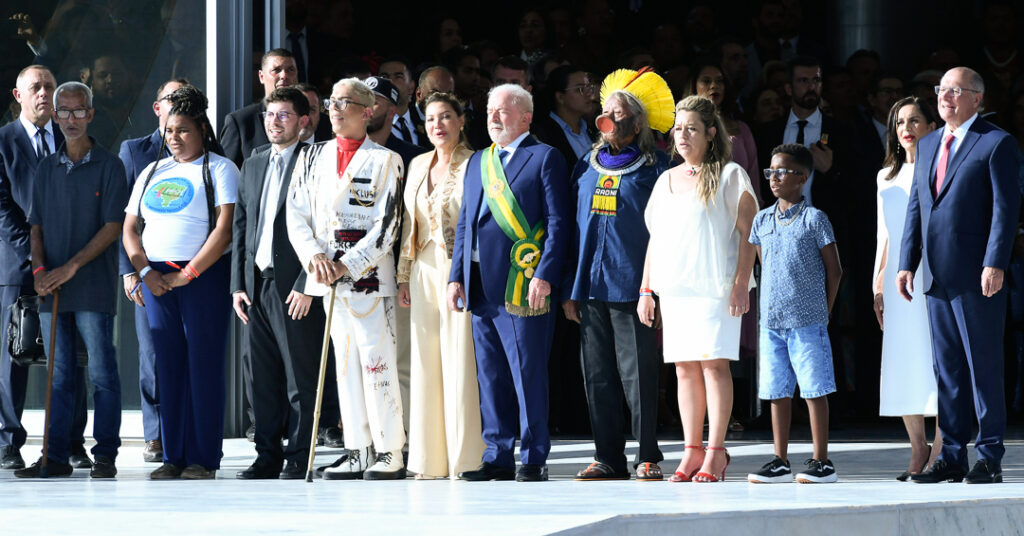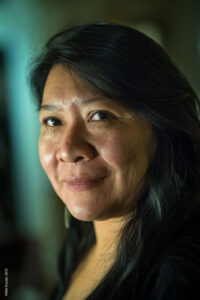
Inauguration of the new Lula government, January 2023, including Indigenous chief Raoni; photo: Senado Federal do Brasil
Maria Fernanda Paes de Barros shares welcome news of support for Indigenous peoples in the new Lula government of Brazil.
President-elect Luiz Inácio Lula da Silva begins his mandate with a plural and inclusive vision, seeking to look at the different people that make up the Brazilian population.
Regarding indigenous peoples, on the day the president took charge, by inviting chief Raoni to go up the ramp at his side and be one of the representatives of the Brazilian people to hold his presidential sash, Lula showed that indigenous peoples will be active protagonists in this government.
On that same day, January 1, 2023, the unprecedented Ministry of Indigenous Peoples was created, which will be headed by indigenous deputy Sônia Guajajara, elected in 2022. Born and raised in the Arariboia Indigenous Land, in Maranhão, Sônia is the first indigenous minister in Brazil. She is internationally recognized for her activist work in defence of the rights of indigenous peoples and the environment and has travelled to dozens of countries denouncing violations of these rights, including at the UN, climate conferences and the European Parliament.
The Ministry of Indigenous Peoples will recognize, guarantee and promote the rights of indigenous peoples; protect isolated and recently contacted peoples; demarcate, defend and manage territories and indigenous lands; monitor, supervise and prevent conflicts in indigenous lands and promote actions to remove invaders from these lands.
Two important bodies that until then were linked to the Ministry of Justice and Social Security also joined the portfolio: the National Foundation for Indigenous Peoples (FUNAI), the largest indigenous policy body in the country since 1967, and the National Council for Indigenous Policy (CNPI), created in 2015 by Dilma Rousseff to ensure the participation of representatives of indigenous peoples in the formulation of public policies. While FUNAI lost its functions under the previous government, the CNPI was extinguished by former President Jair Bolsonaro.
One of the ministry’s focuses will be the resumption of the demarcation of indigenous lands, which has been the main demand of the Brazilian indigenous movement since before the Federal Constitution of 1988. Brazil has 722 known indigenous lands. All of them should have been demarcated by 1993, according to the Federal Constitution, but only 487 were ratified (which is the final act necessary for the demarcation process to be completed).
The creation of a ministry fully dedicated to indigenous demands was one of President Luiz Inácio Lula da Silva’s campaign promises and is the result of a process of struggle by indigenous peoples for leadership and autonomy in Brazilian politics. “More than a personal achievement, this is a collective achievement of the indigenous peoples of Brazil, a milestone in our history of struggle and resistance. The creation of the Ministry of Indigenous Peoples is a confirmation of the commitment that President Lula assumes with us, guaranteeing the autonomy and space to make decisions about our territories, our bodies and our ways of living”, declared Sônia Guajajara in a note sent to the press on the day of her nomination.
With the creation of the Ministry of Indigenous Peoples, Funai, recently renamed the Indigenous Peoples Foundation, regains its functions. Funai is an important public body created in 1967, chaired, also for the first time, by an indigenous woman, federal deputy Joenia Wapichana.
 Joenia Wapichana was elected federal deputy for Roraima in 2018 and is the first indigenous woman to hold the position. She is also the first indigenous lawyer to practice her profession in the country in favour of the rights of indigenous peoples.
Joenia Wapichana was elected federal deputy for Roraima in 2018 and is the first indigenous woman to hold the position. She is also the first indigenous lawyer to practice her profession in the country in favour of the rights of indigenous peoples.
In addition to Funai, the ministry’s policy for demarcating indigenous territories also relies on the Territorial Demarcation Department, which will analyze the demarcation processes forwarded by Funai. It will also be up to the department to promote inspection and removal actions in indigenous territories, monitoring the eventual repossession of lands.
It is important to point out that the appointment of Sônia and Joenia are the result of the triple list created by Apib (Articulation of the Indigenous Peoples of Brazil) in an open letter with the indication of three names to assume the new ministry, representatives of indigenous leaders in the country. In common, the appointment of these two indigenous leaders means the effective recognition of indigenous peoples with special emphasis on the protagonism of indigenous women.
There is great expectation in relation to the new moment of the National Foundation of Indigenous Peoples (Funai), as it is now called, with the choices of Joenia Wapichana for president, and Sonia Guajajara as Minister of Indigenous Peoples. One of the greatest challenges of the indigenous policy in the Lula government will be the budget, the basis for making actions viable.
The indigenous territories that are only awaiting the presidential signature for their homologation are: TI Aldeia Velha, belonging to the Pataxó people, in Porto Seguro, Bahia; TI Kariri-Xocó, from the Kariri Xocó people, in the municipality of São Brás, Alagoas; TI Potiguara de Monte, from the Potiguara people, in Marcação, Paraíba; TI Xukuru-Kariri, from the homonymous people, in the municipality of Palmeiras dos Índios, Alagoas; IL of Tremembé da Barra do Mundaú, of the Tremembé people, in Itapipoca, Ceará; TI Morro dos Cavalos, from the Guarani people, in Palhoça, Santa Catarina; TI Rio dos Índios, of the Kaingang people, in Vicente Dutra, in Rio Grande do Sul; TI Toldo Imbu, Kaingang people, in the municipality of Abelardo Luz, in Santa Catarina; IT of Cacique Fontoura, Karajá, municipality of Luciara, in São Félix do Araguaia, in Mato Grosso; TI Arara do Rio Amônia, from the Arara people, from the municipality of Marechal Thaumaturgo, in Acre; TI Rio Gregório, from the Katukina ethnic group, in Tarauacá, Acre; TI Uneiuxi, from the Nadahup people, in Santa Isabel do Rio Negro, in the Amazon; TI Acapuri de Cima, from the Kokama people, in the municipality of Fonte Boa, in Amazonas.
See also:


